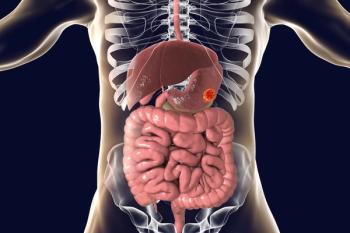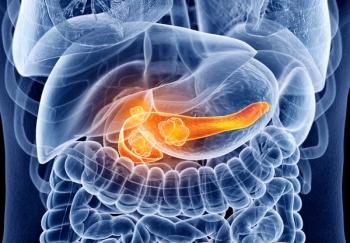
- Oncology Vol 28 No 6
- Volume 28
- Issue 6
EGJ and Esophageal Cancers: Choosing Induction Therapy so as to Err on the Side of Overtreatment Rather Than Undertreatment When Staging Is Imperfect
Until anatomic staging and physiologic prediction models improve, induction therapy serves as a useful crutch that can mitigate the weaknesses in both of these important preoperative tasks.
Esophagogastric adenocarcinoma has long been noted to encompass a group of diseases that are diverse in their epidemiology, causative factors, and pathology-and for which, to date, an equally diverse array of treatment options and therapies have been tried. In many centers, treatment strategies and selection of the oncology team might vary with a shift of a few centimeters in tumor location. With that in mind, this commentary reflects a thoracic surgery point of view, if such a thing exists.
What underscores any attempt to successfully treat, or at best manage, esophagogastric junction (EGJ) and esophageal tumors is accurate staging. When the cancer involves lymph nodes, it is accepted that surgery-only strategies will usually fail. However, there is increased morbidity and mortality risk with induction therapy, and some work has shown that excess mortality might result with inappropriate application of induction therapy.[1]
While randomized clinical trials comparing induction therapy (usually chemoradiation) to “up-front” surgery have been important in formulating our current protocols, it can be challenging to generalize the results of positive trials when there is great variability in staging within and between clinical trials.
Beginning in the 1990s, many randomized trials have evaluated the role of induction therapy in esophageal and EGJ tumors. Significant increases in median survival with induction therapy (compared with up-front surgery) have been demonstrated for locally advanced tumors, although a similar survival has not been seen in all studies, since some of these included early-stage disease.[2-4] Throughout the progress charted by the many trials, there has been simultaneous progress in staging, resulting from the use of positron emission tomography (PET) and endoscopic ultrasound (EUS) to better identify patients at the extremes of the staging charts.
While the accompanying review[5] cites some positive studies that have shaped current therapy, it omits many negative trials that failed to show a benefit, and therefore gives an overly simplified view of the evidence surrounding induction therapy. Despite this potential oversimplification, careful study of the accumulating evidence continues to favor induction therapy. Cancer and Leukemia Group B (CALGB) 9781 was a national cooperative group phase III trial designed to compare induction therapy with initial surgery for stage I-III esophageal and EGJ tumors. This trial was closed early due to poor accrual. However, for patients who were enrolled, a median follow-up of 6 years demonstrated a significant difference in favor of induction therapy for both median and 5-year survival.[6] A recent meta-analysis has identified an overall survival benefit for patients with adenocarcinomas of the stomach, EGJ, and distal esophagus who received induction therapy (hazard ratio, 0.81; 95% confidence interval, 0.73–0.89), with stronger treatment effects identified for EGJ tumors and in patients who received induction chemoradiation rather than chemotherapy alone.[7] Further development of novel induction therapy regimens designed to provide improvements in locoregional control prior to surgical intervention continues; most recently, a phase II study evaluating the addition of panitumumab (an epidermal growth factor receptor monoclonal antibody) to cisplatin, docetaxel, and radiation therapy prior to esophagectomy demonstrated a promising pathologic complete response (PCR) rate of 33% and a near-PCR rate of 20% in patients with locally advanced esophageal and EGJ tumors.[8]
Nonetheless, the wide gap between clinical and pathologic staging of esophageal and EGJ tumors continues to distort our understanding of what a patient needs and to thwart attempts to rationally assign induction therapy. This realization has been highlighted in several recent series. In Crabtree et al, 149 patients underwent initial esophagectomy without induction for esophageal or EGJ tumors after EUS and CT staging from 2000 to 2008. A surprisingly large subset were found to have unanticipated pathologic nodal disease: 24% of patients with clinical T1N0 cancers and 40% of patients with clinical T2N0 tumors.[9] Of note, the majority (90%) of these patients had also undergone PET imaging, yet the clinical stage still failed to trigger induction therapy, which would have been offered had node-positive disease been detected. For patients in this series who were pathologically upstaged, a significant survival difference was detected (40% 5-year survival vs approximately 90% for the patients with pathologic T1/2N0 tumors). Similarly, a different single-institution study of 102 patients with clinically staged T2/3N0 esophageal or EGJ cancers found that 60% of these patients had nodal metastases despite mainstream clinical staging with EUS, CT, and PET.[10]
In a broad, multicenter review of the Society of Thoracic Surgeons (STS) database, these single-institution trends were confirmed. Over 750 patients with clinically staged T2N0 esophageal cancer were studied, and 46% of those who underwent initial surgical intervention were upstaged either in tumor descriptor, nodal status, or both.[11] Of note, there was a significant reduction in pathologic upstaging in those patients who had received induction chemoradiation therapy (38.1% rather than 46%; P = .026).
Given that none of the series mentioned above demonstrated an increase in postoperative 30-day mortality attributable to induction therapy, and that the institutional studies had detected a long-term survival benefit among patients receiving induction therapy, some practitioners have begun to pursue induction therapy in the setting of clinical N0 disease. Certainly, there is the potential for overtreatment in some patients offered this therapy; in the STS series, approximately 25% of patients with T2N0 esophageal cancer who received upfront esophagectomy were actually pathologically downstaged to T1N0.[10] It therefore appears that, given the realities of staging inaccuracy, practitioners are forced to choose between omitting induction for patients with cT2N0 disease and thus missing many N1 patients who need such therapy, or routinely offering induction to patients with cT2N0 disease at the risk of overtreating a minority of patients who have been clinically overstaged.
When a practitioner or multidisciplinary group is deciding between the options of induction and initial surgical management in a patient with EGJ adenocarcinoma, several considerations need to be taken into account. The likelihood of occult locally advanced disease has been detailed above, and unfortunately, no combination of imaging and EUS nodal sampling has been able to markedly improve the staging process to date. Therefore, the ability to treat disease that is probably locoregional but that possibly is micrometastatic, and to gauge the clinical responsiveness of these tumors has led many clinicians to opt for induction therapy in the setting of cT2/3N0 cancers. Induction for T1N0 disease is markedly unusual, but many have considered induction therapy in this setting for similar reasons. Another final consideration when offering induction therapy, especially to patients deemed high-risk due to comorbidities or poor functional status, is that response to induction therapy may predict response to the more morbid surgery that follows it. When patients poorly tolerate standard induction chemoradiation protocols, this may serve as an indication that they are likely to experience increased morbidity and mortality after an esophagectomy, regardless of surgical approach. Until anatomic staging and physiologic prediction models improve, induction therapy serves as a useful crutch that can mitigate the weaknesses in both of these important preoperative tasks.
Financial Disclosure:The authors have no significant financial interest in or other relationship with the manufacturer of any product or provider of any service mentioned in this article
References:
1. Rice TW, Mason DP, Murthy SC, et al. T2N0M0 esophageal cancer. J Thorac Cardiovasc Surg. 2007;133:317-24.
2. Walsh TN, Grennell M, Mansoor S, Kelly A. Neoadjuvant treatment of advanced stage esophageal adenocarcinoma increases survival. Dis Esoph. 2002;15:121-4.
3. Bosset JF, Gignoux M, Triboulet JP, et al. Chemoradiotherapy followed by surgery compared with surgery alone in squamous-cell cancer of the esophagus. N Engl J Med. 1997;337:161-7.
4. Kelsen DP, Ginsberg R, Pajak TF, et al. Chemotherapy followed by surgery compared with surgery alone for localized esophageal cancer. N Engl J Med. 1998;339:1979-84.
5. Sandler S. Esophagogastric junction and gastric adenocarcinoma: neoadjuvant and adjuvant chemotherapy, and future directions. Oncology (Williston Park). 2014;28:505-12.
6. Tepper J, Krasna MJ, Niedzwiecki D, et al. Phase III trial of trimodality therapy with cisplatin, fluorouracil, radiotherapy, and surgery compared with surgery alone for esophageal cancer: CALGB 9781. J Clin Oncol. 2008;26:1086-92.
7. Ronellenfitsch U, Schwarzbach M, Hofheinz R, et al. Perioperative chemo(radio)therapy versus primary surgery for resectable adenocarcinoma of the stomach, gastroesophageal junction, and lower esophagus. Cochrane Database Syst Rev. 2012; 31:1-88.
8. Lockhart AC, Reed CE, Decker PA, et al. Phase II study of neoadjuvant therapy with docetaxel, cisplatin, panitumumab plus radiation therapy followed by surgery in patients with locally advanced adenocarcinoma of the distal esophagus (ACOSOG Z4051). Ann Oncol. 2014 Feb 20. [Epub ahead of print] 9. Crabtree TD, Yacoub WN, Puri V, et al. Endoscopic ultrasound for early stage esophageal adenocarcinoma: implications for staging and survival. Ann Thorac Surg. 2011;91:1509-16.
10. Stiles BM, Mirza F, Coppolino A, et al. Clinical T2-T3N0M0 esophageal cancer: the risk of node positive disease. Ann Thorac Surg. 2011;92:491-8.
11. Crabtree TD, Kosinski AS, Puri V, et al. Evaluation of the reliability of clinical staging of T2N0 esophageal cancer: a review of the Society of Thoracic Surgeons database. Ann Thorac Surg. 2013;96:382-90.
Articles in this issue
Newsletter
Stay up to date on recent advances in the multidisciplinary approach to cancer.

















































































